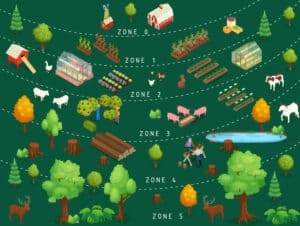As a permaculture designer and consultant, I am often asked questions about plant spacing. I am sometimes asked for precise rules about how far apart plants should be from one another.
When it comes to rigorous plant spacing rules, I always try to encourage a more nuanced view and, in some respects at least, suggest that you throw the rule book out the window.
Polycultures and companion planting are both about rethinking how we order and lay out our food-producing gardens.
Forget strict row growing and other very ordered approaches like square foot gardening. Instead, try to think about ordering your vegetable garden in a more natural way, adapting to your particular space, and taking a more holistic approach.
This is not to say that we should not consider the space that different plants require. Merely that this is not the only consideration. In a vegetable garden, the plants we choose and, crucially, how we combine them is just as important. And sometimes, this may mean letting strict spacing rules slide.
The permaculture-related concepts of polycultures and companion planting involve thinking carefully about the interactions between different plant species in our gardens. They involve moving away from a mono-crop approach and introducing more diversity and more beneficial interactions, into our growing areas.
Below, we will explore the terms polycultures and companion planting and what we mean by them both. We’ll talk about why taking this sort of approach to garden planning and layout is such a good idea, and give you some tips and tools to help you begin to plan your own garden in this way.
What are Polycultures?
In gardening and in farming, a polyculture is a system in which multiple different plant species grow in the same area at the same time.
This system aims to tackle the issues with and improve upon the results of, mono-crop systems, which contain just one crop or plant type in a particular area.
Polycultures can be combinations of many different types of plant – annual crops, edibles and ornamentals, or perennial plants in systems like forest gardens.
What is Companion Planting?
Companion planting is a concept closely related to the above. It involves thinking about good and bad neighbors for each of the crops we grow.
One important thing to remember is that companion planting is not an exact science. You may be surprised, after reading a lot of advice online and elsewhere about the best combinations, to learn that we actually know very little about plant interaction.
Most companion planting is often not rigorously scientific. Rather, is it a series of suggestions that have anecdotally worked well for other gardeners and which are based on some ‘best guesses’ about beneficial plant combinations.
In an organic garden, it is very important to remember that everything is connected. In order to work with nature rather than fighting it, we need to look at plants and our gardens holistically. We cannot simply consider a specific plant in isolation or we risk missing the bigger picture.
Companion planting is often a case of common sense. The more we learn about the various needs of the different crops and other plants we grow, the easier it is to determine which other plants might be good neighbors for them and which will not.
But while we do know that some plants are or are not compatible with others, for fairly obvious reasons, it is important to remember that some plants can make good companions, and we do not know exactly why.
Companion planting has been surprisingly little studied, and yet many gardeners find it extremely useful to take a companion planting approach in their organic gardens. With companion planting them, experimentation is key. Over time, you will gain experience as a gardener and get to know your own garden better. You will find some companion planting combinations which work particularly successfully for you.
The Goals of Companion Planting
Companion planting is, first and foremost, about considering the ways in which we can increase the number of beneficial interactions between plants, without increasing competition between them to a detrimental degree.
Competition is something that is found in nature’s systems. But when excessive competition is present in a system, for water or nutrients or space, then plant growth can suffer.
Sometimes, there may be some competition within a planting scheme, and yield of one plant may be reduced. However, even where yield of one crop is reduced, overall yield can still be higher when you grow more than one plant species in a given area.
The right companion planting combinations involve thinking about the growth habit, form, root system and environmental needs of different plants, and combining them in beneficial ways.
Companion planting can be useful to:
- Make The Most Of Your Space
- Improve Environmental Conditions For Neighbouring Plants
- Maintain Fertility in Your Growing Areas
- Repel, Confuse or Distract Pest Species
- Attract Beneficial Wildlife
Companion planting to make the most of your space might involve:
- Planting quick growing crops between slower growing ones in annual beds.
- Placing plants with different root systems and requirements between or alongside others.
- Layering plants, with shorter non-competitive ones below taller ones.
One plant may improve the environment for another by:
- Providing support.
- Increasing humidity.
- Creating shade.
- Reducing water loss by providing ground cover.
Maintaining fertility often involves the use of:
- Nitrogen fixing plants.
- Dynamic accumulators (for example, those with deep tap roots that can reach nutrients from deeper in the soil).
- Plants which grow swiftly, generating lots of organic matter for mulch and compost creation.
In organic pest control, we might use:
- Certain aromatic plants that repel certain pest species or confuse or distract them by masking the scents of the crops on which those pests typically prey.
- Trap crops that attract pest species – helping to keep them away from valuable crops.
This goes hand in hand with attracting beneficial predatory wildlife – such as predatory insects that prey on aphids, for example.
Another key group of species drawn in my companion plants are bees, and other pollinators. Of course, these are crucial for good fruit set on insect-pollinated crops. Our goal should be to make sure there are plenty of enticing flowers for pollinators in our gardens throughout as much of the year as possible.
Drawing in as wide a range of wildlife as possible in your garden is always a good idea. The greater the biodiversity of plant and animal life within a system, the greater the number of beneficial interactions between species there can be. And the greater the number of beneficial interactions, the more stable and resilient the system will become.
Types of Companion Planting
There are a number of different ways to combine plants to achieve the goals of companion planting. These include:
- Intercropping
- Interspersed planting
- Living mulches
- Border planting
- Guilds and polycultures
Intercropping
The first type of companion planting to consider is intercropping. This simply involves growing one type of plant or crop between rows of another. This type of companion planting certainly helps you make the most of your space, and can integrate well in a more traditional planting scheme, with ordered rows of fruits and vegetables.
Examples of this include growing rows of nitrogen fixing peas or beans between rows of potatoes, growing lettuces between brassica plants, or intercropping rows of onions and carrots. However, there are a wide range of crops that can be overlapped in space and time to make the most of the space and to confer other benefits on one another.
Interspersed Companion Plants
Companion planting, however, does not just have to take such an orderly approach. Sometimes, planting areas may be arranged much more loosely, with beneficial companion plants simply placed randomly into the mix, between other plants.
Mixed seeds may even be broadcast over an area, for different edible plants and their companions to come up as they may in certain cases.
Living Mulches
In and around kitchen garden beds, you might also use living mulches.
Low-growing plant species which no not compete too much with the main crops in a bed or growing area (due to their different root systems or different nutritional needs) can be used to improve environmental benefits by covering the soil around your crops and conserving moisture just like other types of mulch. However, as living mulch is made of living plants, it can often confer other companion planting benefits too.
This is another type of companion planting to consider around certain crops.
Border Planting
Companion planting also includes planting beneficial plant species around the edges of a bed or growing area, where they can serve as a partial protective barrier for the main crops.
Aromatic herbs or alliums (onion family plants), for example, placed around the edges of the beds can help to keep the main crops in those areas safe.
Moving Beyond Companion Planting to Polyculture Creation
It is worthwhile remembering that companion planting is not always about adding just one additional type of plant. Often, the best companion planting schemes are those which add several different species to each growing area.
Guilds are a specific type of polyculture, where all the plants centre around one key plant. This is commonly a term used to refer to the planting around fruit trees. But it can also be used to refer to planting around another perennial, or a specific annual crop. All of the plants in a guild are specifically chosen to benefit the plant at their heart.
Other polycultures can focus less on the health and vitality of a central plant species and more on the function of the system as a whole. In these types of growing scheme, no one plant is meant to predominate. All plants are important and are selected carefully to mimic a thriving natural ecosystem while also meeting human needs.
Plant Spacing in Polyculture Planting
Polyculture planting, remember, is all about creating ecosystems within each planting area that are as diverse and resilient as possible. This type of planting may be based around row planting or grid planting schemes. But generally takes a much more relaxed, looser approach to plant placement and plant spacing.
In an annual polyculture, the needs of individual plants are obviously taken into account. But often plants are placed far more densely than in traditional planting schemes, and without the geometric order of grid planting. This looser approach to spacing takes into account the ways in which the plants will interact with one another, as well as just the individual needs of the plants themselves.
Determining how much space you need for different plants in a polyculture growing area is far less exact than in other growing methods such as row growing or grid gardening.
Spacing ideas may come, originally, from one of the above concepts. But after the initial consideration of a plant’s spacing needs, those creating polycultures will often think about how other plants can be included to fully utilise the space, maximise overall yield and improve overall results.
Examples of Polycultures
To better understand how the ideas of companion planting can be utilised to create polycultures in your garden, let’s take a look at a few examples of polyculture planting schemes:
Perennial Polycultures
In permaculture gardens, fruit tree guilds and forest gardens are among the common perennial polycultures that are created. The later often contains a number of the former within the larger scheme.
Perennial polycultures might also be creating using perennial vegetables, herbs and other useful flowering plants. A polyculture containing strawberries, perennial brassicas, perennial alliums, horseradish and rhubarb is just one example…
Outside of primary food producing zones, perennial polyculture might include schemes like perennial wildflower meadows, that are a great wildlife-friendly replacement for a mono-crop grass lawn.
Annual Polycultures in a Kitchen Garden
In annual vegetable beds, you will not find as many layers as you would do in a true forest, or forest garden, but by creating layers of planting in a polyculture, you can mimic the forest system to a degree and can benefit from the beneficial interactions that occur between the various plants species.
Layering plants is not only about creating a series of tiers of layers that create shade and create a range of other beneficial interactions. It can also be about making the most of the space throughout the whole gardening year.
We can layer in time as well as in space by, for example, sowing fast-growing radishes with our parsnips, or other slow-growing plants, so as to get an extra yield before the main crop is ready to harvest.
Seeking out beneficial companion plants for key crops in a kitchen garden is just the first part of the puzzle. Remember, we need to look not only at two plants in combination, but at groups of multiple plants that work cohesively together in our growing areas.
For example, tomatoes and basil are key companion plants that benefit one another. But these can also be combined with, for example, garlic and French marigolds to create a thriving polyculture in your garden.
Another famous polyculture planting scheme is that of the ‘three sisters’ corn, beans and squash. Combining these three, perhaps also with other beneficial companions like radishes and nasturtiums, can be a good idea in many gardens.
These are just a few examples to help you get started with polyculture growing where you live.







